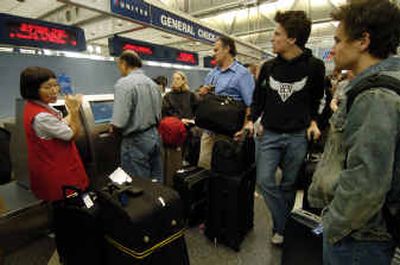Airlines warned to ease delays in Chicago

WASHINGTON — Even if you never fly through Chicago, your plane may be delayed because of congestion at O’Hare International Airport.
Delays at the airport ripple through the nation’s air traffic system. So federal officials now are warning that they will fix the problem if the airlines do not.
“As Chicago goes, so goes the system,” Marion Blakey, head of the Federal Aviation Administration, said Wednesday. “We will have to take action unilaterally if we can’t come to an agreement.”
Blakey summoned executives from every major domestic airline to FAA headquarters in an effort to jawbone them into agreeing to reduce their O’Hare schedules.
O’Hare, which handles both cargo and passenger traffic, has more takeoffs and landings each year than any other airport in the world.
On an average weekday this summer, just under 3,000 planes are taking off and landing at O’Hare. During the first six months of this year, there were 490,987 flights arriving and departing the airport.
About two-thirds of arrivals are on-time this year, compared with the 82 percent systemwide goal the FAA sets.
“If it weren’t for O’Hare, we’d be making that goal,” Blakey said.
Flights departing behind schedule from Chicago will be late everywhere else they fly that day. Seven in 10 passengers flying to O’Hare connect to other flights.
Many planes pass through Chicago’s airspace because of its location — right in the middle of the continent. Sometimes the sky over Chicago gets so crowded that air traffic controllers have to delay flights that land elsewhere.
When O’Hare gets jammed, controllers delay takeoffs at other airports to give O’Hare time to clear out its backlog.
It does not help that the fastest growing airport in the country is about 15 miles to the south of O’Hare. Midway Airport now handles an average of 1,100 takeoffs and landings daily.
Adding to the congestion are small regional jets, which now account for four out of 10 flights at O’Hare. Unlike the propeller planes they replaced, regional jets use the same runways and fly in the same airspace as bigger planes, but carry fewer passengers.
Also, unusual weather patterns this year have caused a high number of severe thunderstorms in some of the country’s most congested areas — from Chicago east through the upper Midwest, the Northeast and Mid-Atlantic.
On Wednesday, thunderstorms en route to Chicago caused average arrival delays of 51 minutes.
But airlines, enjoying a resurgence since the Sept. 11 attacks, have compounded the problem by adding too many scheduled flights, Blakey said.
“You can’t control the weather, but you can control your schedules,” she told airline officials.
Blakey said the problem started in November, when airlines expanded their schedules.
That month, flights arrived on time 60 percent, down from rates of 75 percent to 80 percent in earlier periods, she said.
United and American airlines, which handle 88 percent of O’Hare flights, agreed to reduce their schedules during peak hours by 7.5 percent.
Other carriers, though, added O’Hare flights to their schedules.
The resulting increase in delays led to Wednesday’s meeting, during which airline executives met individually with FAA officials to propose schedule reductions.
David Stempler, president of the Air Travelers Association, said the real solution is an updated and expanded O’Hare.
The city submitted a plan in 2001 to reconfigure runways and create new ones to cut flight delays and increase flight capacity. But the $15 billion plan has run into stiff opposition. New runways at O’Hare are believed to be years away.
Blakey acknowledged that more pavement is the solution to reducing O’Hare’s congestion.